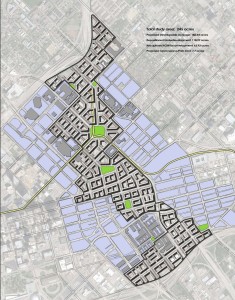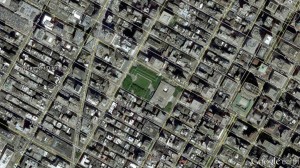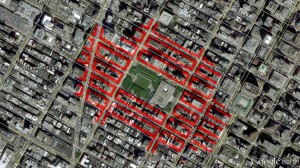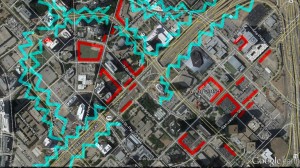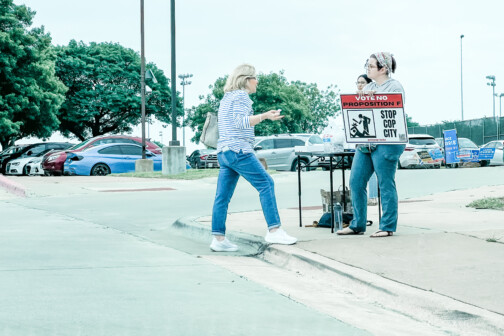Wick Allison wrote a piece yesterday about Woodall Rodgers Deck Park, aka Klyde Warren Park. I’d link to it, but apparently there is something going on with FrontBurner’s archives. The gist of it was, there were a lot of people in the Arts District and more specifically KWP, and there was no provision of beer, nor enough other restaurants outside of the ever-present food trucks. Dare we say, there wasn’t enough accommodation to keep up with the demand through the integration brought about by KWP. A little interconnectivity can go along way. But is it enough? And can the area support many more restaurants?
I was out there Saturday as well. It was very crowded. So crowded in fact, that waiting in line for the food trucks was undesirable (nor is there enough sidewalk space for these lines but that’s tangential). And yes, while I was out there, I was thinking, “man, I’d really like a beer.” We live downtown and since we do live downtown, we ended up heading back towards Main Street, about a half-mile walk that is made to feel even longer as it is primarily past parking garages and parking lots, all serving the various offices, the Arts District, and the all the drive-to park attendees on Saturday.
A half-mile. This is the distance between pulse points, between signs of life. Mostly because of the freeways allow people to commute in easily and therefore live much further away. An infrastructural subsidy of sprawl. That’s perhaps the most interesting thing about KWP. That’s the very thing that makes it more interesting than a typical park is the very thing that limits is ultimate potential. The freeway it covers (and is served by) is what creates dead zones around it. Border vacuums, in Jacobsian terminology.
You don’t find restaurants in border vacuums because there is no life. Connectivity is limited by the wall that is the freeway, regional movement at the expense of local movement. It is a sum subtraction on overall site connectivity. Low connectivity, low life, little demand, no supply of accommodation in the form of restaurants or bars.
Yes, it’s interesting. Yes, decking over a freeway is novel (but of course, an 18,000 person suburb of Bilbao, SP has a similarly sized deck park over a freeway). But this is also the very fact that will limit it’s long-term vitality in comparison to say, if it was an exact same size, scale, location as it is now without the freeway underneath it at all.
Wick acknowledges that yes, there will be a restaurant opening in the park in conjunction with the restaurant under construction immediately across the street. If we don’t think these are enough, supply not meeting demand, there are other opportunities nearby where that demand can be met.
Above we see KWP and Bryant Park in Manhattan at similar scale, both centered within their respective aerials.
The obvious noticeable difference is in the street network immediately surrounding the parks. As highlighted above, virtually every block in the immediate vicinity can support ground floor retail and are viable for restaurants/cafes/bars/coffee shops/etc.
Here are those very same things mapped. They are fairly evenly dispersed throughout, a by-product of a very regular grid within a highly, densely interconnected place and therefore a highly dense city.
When looking at a similar map of KWP in the area, very few areas currently support restaurant life. This is unsurprising, but fluid as this map (nor the real world and restaurant market) hasn’t fully adapted or matured around the park. After all, the park is new. But it’s also difficult to imagine exactly where these might occur that really populate the area.
Above, I’ve highlighted the obvious places where the land isn’t spoken for and/or could be developed to support restaurants and retail. It’s fairly sparse. It’s mostly the undeveloped land and/or parking. In blue, I’m showing areas that will naturally resist outdoor cafe life due to the road engineering as I showed in this map: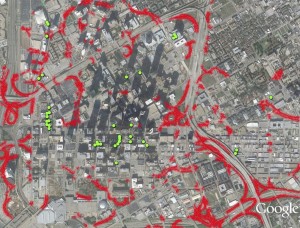
Cafes avoid conventional road engineering geometries because 1) the curve radii are so high that they encourage high speed traffic which is undesirable for pedestrians and cafe-goers to be near and 2) the dendritic nature clips the grid and undermines network connectivity.
The previous map showing the potential for restaurant space around KWP might very well be similar to its capacity for life and vibrancy in relation to other places like Bryant Park.
You might say, that is unfair, we don’t have NYC densities. Of course, this is an argument that underscores my point. It belies the underlying dynamic that interconnectivity (global plus local minus the negative impact of global’s physical infrastructural presence, which is nearly always negative) is the key determinant of population density (via opportunity and desirability) which then drives demand for accommodation (like restaurants) and decoration (more beautiful places and spaces).
Woodall Rodgers Highway is the underlying problem. Yes, the park offers a degree increase of connectivity. However, it only slightly mitigates the disconnective nature of the highway that creates demand for parking as well as the Arts District’s mostly homogenous and land consumptive nature that prevents enough residential density from achieving levels necessary to provide stability. It will be hard for KWP to keep drawing outsiders to the park at current levels. Particularly as the visitors return home to whatever suburb and begin demanding similar accommodation closer to their home.
As I always say, what goes in the park is often not as relevant (as long as it’s not bad, as in what used to be in Bryant Park that made it visually and physically impermeable and therefore less desirable) as the connections and vibrancy immediately outside the park in terms of the overall quality, character, and success of the park. Connections and vibrancy that is minimized by the very thing the deck park simply covers up rather than truly fixes. If we truly want our places to be world class we have to understand the dynamics that produce world class demand. We can start by tearing out IH-345. Just imagine the potential for parks with development around them:
